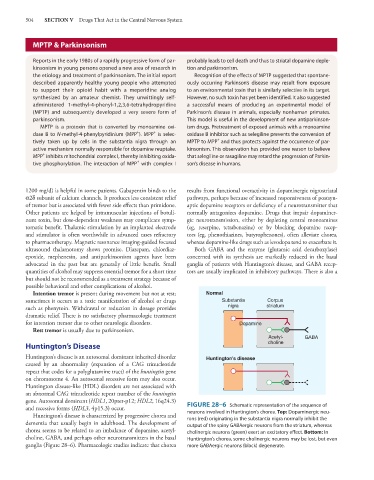Page 518 - Basic _ Clinical Pharmacology ( PDFDrive )
P. 518
504 SECTION V Drugs That Act in the Central Nervous System
MPTP & Parkinsonism
Reports in the early 1980s of a rapidly progressive form of par- probably leads to cell death and thus to striatal dopamine deple-
kinsonism in young persons opened a new area of research in tion and parkinsonism.
the etiology and treatment of parkinsonism. The initial report Recognition of the effects of MPTP suggested that spontane-
described apparently healthy young people who attempted ously occurring Parkinson’s disease may result from exposure
to support their opioid habit with a meperidine analog to an environmental toxin that is similarly selective in its target.
synthesized by an amateur chemist. They unwittingly self- However, no such toxin has yet been identified. It also suggested
administered 1-methyl-4-phenyl-1,2,3,6-tetrahydropyridine a successful means of producing an experimental model of
(MPTP) and subsequently developed a very severe form of Parkinson’s disease in animals, especially nonhuman primates.
parkinsonism. This model is useful in the development of new antiparkinson-
MPTP is a protoxin that is converted by monoamine oxi- ism drugs. Pretreatment of exposed animals with a monoamine
+
+
dase B to N-methyl-4-phenylpyridinium (MPP ). MPP is selec- oxidase B inhibitor such as selegiline prevents the conversion of
+
tively taken up by cells in the substantia nigra through an MPTP to MPP and thus protects against the occurrence of par-
active mechanism normally responsible for dopamine reuptake. kinsonism. This observation has provided one reason to believe
+
MPP inhibits mitochondrial complex I, thereby inhibiting oxida- that selegiline or rasagiline may retard the progression of Parkin-
+
tive phosphorylation. The interaction of MPP with complex I son’s disease in humans.
1200 mg/d) is helpful in some patients. Gabapentin binds to the results from functional overactivity in dopaminergic nigrostriatal
α2δ subunit of calcium channels. It produces less consistent relief pathways, perhaps because of increased responsiveness of postsyn-
of tremor but is associated with fewer side effects than primidone. aptic dopamine receptors or deficiency of a neurotransmitter that
Other patients are helped by intramuscular injections of botuli- normally antagonizes dopamine. Drugs that impair dopaminer-
num toxin, but dose-dependent weakness may complicate symp- gic neurotransmission, either by depleting central monoamines
tomatic benefit. Thalamic stimulation by an implanted electrode (eg, reserpine, tetrabenazine) or by blocking dopamine recep-
and stimulator is often worthwhile in advanced cases refractory tors (eg, phenothiazines, butyrophenones), often alleviate chorea,
to pharmacotherapy. Magnetic resonance imaging-guided focused whereas dopamine-like drugs such as levodopa tend to exacerbate it.
ultrasound thalamotomy shows promise. Diazepam, chlordiaz- Both GABA and the enzyme (glutamic acid decarboxylase)
epoxide, mephenesin, and antiparkinsonism agents have been concerned with its synthesis are markedly reduced in the basal
advocated in the past but are generally of little benefit. Small ganglia of patients with Huntington’s disease, and GABA recep-
quantities of alcohol may suppress essential tremor for a short time tors are usually implicated in inhibitory pathways. There is also a
but should not be recommended as a treatment strategy because of
possible behavioral and other complications of alcohol.
Intention tremor is present during movement but not at rest; Normal
sometimes it occurs as a toxic manifestation of alcohol or drugs Substantia Corpus
such as phenytoin. Withdrawal or reduction in dosage provides nigra striatum
dramatic relief. There is no satisfactory pharmacologic treatment
for intention tremor due to other neurologic disorders. Dopamine
Rest tremor is usually due to parkinsonism.
Acetyl- GABA
Huntington’s Disease choline
Huntington’s disease is an autosomal dominant inherited disorder Huntington’s disease
caused by an abnormality (expansion of a CAG trinucleotide
repeat that codes for a polyglutamine tract) of the huntingtin gene
on chromosome 4. An autosomal recessive form may also occur.
Huntington disease-like (HDL) disorders are not associated with
an abnormal CAG trinucleotide repeat number of the huntingtin
gene. Autosomal dominant (HDL1, 20pter-p12; HDL2, 16q24.3)
and recessive forms (HDL3, 4p15.3) occur. FIGURE 28–6 Schematic representation of the sequence of
neurons involved in Huntington’s chorea. Top: Dopaminergic neu-
Huntington’s disease is characterized by progressive chorea and rons (red) originating in the substantia nigra normally inhibit the
dementia that usually begin in adulthood. The development of output of the spiny GABAergic neurons from the striatum, whereas
chorea seems to be related to an imbalance of dopamine, acetyl- cholinergic neurons (green) exert an excitatory effect. Bottom: In
choline, GABA, and perhaps other neurotransmitters in the basal Huntington’s chorea, some cholinergic neurons may be lost, but even
ganglia (Figure 28–6). Pharmacologic studies indicate that chorea more GABAergic neurons (black) degenerate.

